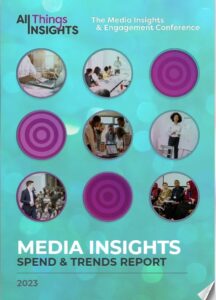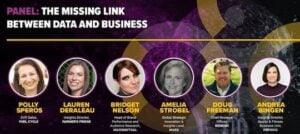From the latest about the delicate balance between artificial intelligence and human insights, to more specific themes about insights leadership, culture and teams, to diving deep into topics like brand health tracking, synthetic data and AI-enhanced qualitative research, TMRE didn’t disappoint.
Navigating Change
With Proctor & Gamble celebrating 100 years of driving consumer experiences through insights, it seemed fitting to kick off TMRE with Kirti Singh, Chief Analytics, Insights & Media Officer at P&G, speaking about, “A Century of Curiosity: P&G Analytics & Insights Discovering the Future.”
As Singh looked at the company’s insights-rich history, one couldn’t help but be inspired by this “century of curiosity,” filled by brands like Bounty, Dawn and Tide. But it was really the changing role of insights through the decades that helped bring those consumer-centric brands and those superior brand experiences to life for consumers.
“Insights have become genuine partners driving growth,” says Singh.
To bring humans, data, and technology together for 100 years is no small feat. But it’s what makes transformational improvements possible and gives researchers the power to transform. As for what makes a brand consumer centric, Singh brought up a few key points to leverage:
- Leadership Intent (winning hearts and minds)
- Curiosity Mindset (having a learning mindset)
- Business Acumen (consumer-centricity as a business strategy)
Slices of Insights Inspiration
If Singh set the stage for the first day of TMRE, Stefania Gvillo, SVP, Chief Analytics & Insights Officer at Domino’s Pizza, served up a few slices of wisdom, insights and inspiration to close the first day of the conference.
In the keynote, “Insights & Influence Ignited: Leadership, Impact & The Art of Storytelling,” Gvillo examined the impact of storytelling, curated learning, insights leadership through purpose and authenticity, and her experiences as a strategic partner at Domino’s. Gvillo made a few key storytelling points that could serve anyone in the insights community looking to create impactful stories:
- Be a Journalist (not a novelist). Keep it simple and concise, remember the audience, and balance context with the message.
- Know Your Audience. Craft stories, build trust and connect and cater to different audiences. Focus on the consumer experience.
- Evoke Emotion. Create relevancy.
- Ignite Action. This leads to what and why to what’s next? This is your call to action and recommendation.
- Embrace Technology. Create inspired solutions.
Data storytelling and forming end-to-end partnerships is also important, to turn insights to action, says Gvillo. “How do you close the loop?” she asks. “Are you invited to the table with an active role? It’s the collaborative methodology that sets us apart to drive action. Be a change agent.”
Ultimately, “we are all influencers honing that actionable message,” says Gvillo. But by building a learning culture, experimenting, and staying relevant we can learn fast and stay ahead of trends.
Becoming A Choice Architect
While Gvillo fired up the TMRE crowd with her storytelling, Katy Milkman took the main stage the next day to provide a little bit of wisdom and wit behind what’s known as choice architecture, which is the ways in which we can influence decisions as businesses and as individuals. Milkman is an economist, bestselling author and professor at The Wharton School of the University of Pennsylvania.
Her keynote, “Influencing Decisions Through Choice Architecture,” examined ways in which a choice is presented (on screens and in person), which can create an extremely valuable tool for improving employee outcomes and consumer choices. This science of “choiceology” can help identify consumer needs and wants and nudge consumers to make better choices. The way the environment is constructed can also help steer consumers into making better choices and improving decision making. Milkman presented a set of points that can help improve those decisions:
- Set Helpful Defaults (the path of least resistance)
- Prompt People to Plan (and to follow through)
- Leverage Social Norms (reasonable choices)
- Timing Principles (the power of timing)
In these ways, as choice architects we can influence behavior, encourage consumers to have more fresh start moments, reduce obstacles to change and drive better solutions.
Creating the Next Hit Product
As Milkman provided a fascinating look at making better choices, the closing keynote that day from Derek Thompson gave a just as compelling examination into a different avenue of consumer choice—how some products become mega hits while others do not.
In “The Anatomy of Viral Trends & Hit Products,” Thompson, host of Plain English, bestselling author of Hit Makers and On Work, staff writer at The Atlantic, presented an interesting look at how consumers liking new things, and the success of such products, is actually a myth of modernity. In other words, people prefer the power of familiarity. This in essence influences human discovery and human innovation, among other factors, creating a formula of familiarity yet also still one of surprise.
Thompson brought up these principles from his book, “Hit Makers,” that in terms of new products, consumers tend to gravitate towards MAYA (Most Advanced Yet Acceptable) designs. The MAYA principle suggests that the ideal design is a balance between what’s familiar and what’s novel. If a design is too unfamiliar, customers may tune it out, and if it’s too familiar, they may look past it.
“There is a love of new things, yet a fear of new things and design is at the intersection, where we can combine the new and the familiar,” says Thompson. “Make your product surprising yet familiar.”
Thompson further asks product designers, “Where are you on the surprise/familiarity spectrum?” Yet, despite this spectrum of the familiar, Thompson suggests that the surprise element still gives us room in life and business for art, bravery, risks and experimentation.
Do You Speak My Language?
Charles Duhigg, New York Times bestselling author and Pulitzer Prize-winning columnist at The New York Times Magazine, closed out TMRE with a keynote on “Supercommunicators—The Power of Conversation and Hidden Language of Connection.” Duhigg presented an insightful exploration of why some conversations succeed while others fail. How does communication work within our brains, our families, our workplaces, and our communities?
As we go about our lives, we often mistakenly identify practical, emotional and social conversations. Sometimes we recognize these types of conversations, but other times we don’t. Duhigg makes the case that we can better understand our communications and connect with others when we can match the right conversations.
There is a method of active surveillance and heightened emotional intelligence that we can achieve within our own conversations to take them to the next level, notes Duhigg.
Some of this art of conversation might have to do with the types of questions that we ask others. We are also influenced by how we listen and how we show conversational empathy with others. This can lead to reciprocal authenticity as we make genuine connections with others with the conversations and stories that we tell and share.
All of the TMRE keynotes provided a window into the skills, culture and leadership of the insights professional. And as the keynotes showed, it seems that the art of storytelling, in any profession, is indeed a skill worth learning, telling, and sharing with others as we communicate our own unique stories.
Editor’s Note: The next TMRE will take place October 28-30, 2025, at the Paris Las Vegas Hotel in Las Vegas, NV.
Contributor
-

Matthew Kramer is the Digital Editor for All Things Insights & All Things Innovation. He has over 20 years of experience working in publishing and media companies, on a variety of business-to-business publications, websites and trade shows.
View all posts













































































































































































































































































